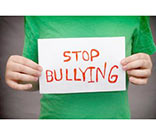|
|
 |
|
The views expressed on this page are soley
those of the author and do not
necessarily represent the views of County
News Online
|
 |
Start Talking
Know! To
Recognize and Respond to Bullying
10/25/2016
Bullying touches the lives of at least one out of every four children
in the U.S. In this year alone, approximately 13 million youth, from
preschool to high school, will experience it. Yet, many parents do not
even know their child is a victim. One study revealed that as many as
64 percent of youth who were bullied did not tell a parent, teacher or
any other adult about it. Will your child be one of them? Would you
recognize it and know how to respond?
Bullying can take various forms. While the schoolyard bully who pushes
around smaller children or steals their lunch money still exists, the
term “bullying” includes several other negative behaviors. Bullying can
be physical, verbal, sexual, emotional, cyberbullying or combinations
of the five. In any case, according to Pacer Center’s Teens Against
Bullying, it’s considered bullying if:
The person is being hurt, harmed or humiliated with words or behavior.
It can be behavior that is repeated, or it can be a single incident.
It is being done intentionally.
The person being hurt has a hard time defending him/herself from the
behavior.
Those who are doing it have more power, meaning, they are older,
physically stronger, have a higher social status, or if multiple youth
“gang up” on another child.
Any parent whose child has been the target of bullying knows the pain
it can cause. Sometimes the pain is physical, but many times it is
emotional agony. In addition to decreased self-confidence and
self-esteem, children who are bullied may develop anxiety and
depression, increased feelings of sadness and isolation and/or a change
in sleeping and eating patterns; they are more likely to miss, skip or
drop out of school; these youth are at increased risk of suicide, as
well as increased risk for tobacco, alcohol and other drug use. These
are devastating effects that can follow a person well into adulthood.
Parents need to discuss bullying with their children, to help them
understand what it is and what it can do to a person. Young people must
also be told: Bullying is never ok. No one deserves to be bullied. All
youth have the right to feel and be safe. And everyone deserves to be
treated with respect.
If you suspect or know your child is being bullied, here are some steps
you can take:
Talk, Listen, Document: Encourage your child to talk about the
situation, then listen without judgment, gathering, then documenting as
much information as you can. That way, if it gets to the point where
you need to contact school personnel, law enforcement or others to
intervene, you have a record to share with them.
Support and Empower Your Child: Let your child know the bullying is not
their fault and they are not alone – that you are there for them. But
keep in mind that typically, a child who shares their bullying
experience with a parent, teacher or other adult isn’t looking for that
adult to fix it, they’re more likely wanting support and guidance on
creating an action plan to help stop the bullying.
Know Your Child’s Rights: Different states and school districts within
each state have their own policies on bullying. Visit StopBullying.gov
to learn about bullying laws in your state; contact your child’s school
to learn about their individual school policy.
Experts warn parents to resist the urge to directly contact the other
parents involved. It typically only makes matters worse. Leave the
mediating up to school personnel or law enforcement officers.
Sharing with your child what bullying is and the hurt it can cause is
the first step in awareness and prevention. Knowing how to respond if
you suspect or know your child is being bullied is essential to their
well-being. For further information and advice on this topic, visit
Pacer’s National Bullying Prevention Center.
Learn how to get the conversation started at StartTalking.Ohio.Gov
|
|
|
|

